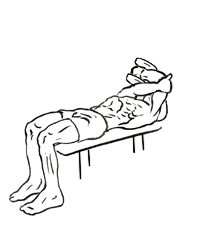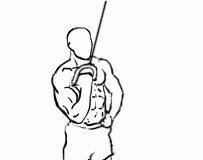Last Updated on September 26, 2014
The Single Arm Pronated Triceps Extension with Dumbbell is an advanced and highly effective exercise that targets the triceps, the large muscle located on the back of the upper arm. As a single-arm movement, this exercise not only helps to isolate the triceps but also improves symmetry, strength, and muscular control in each arm individually.
Whether you’re looking to sculpt well-defined arms or boost your pushing power for other exercises, this workout deserves a place in your fitness routine. In this in-depth guide, we’ll explore the benefits, proper execution, common mistakes, and advanced tips to optimize this exercise for maximum results.
Why the Single Arm Pronated Triceps Extension is Important
The triceps play a crucial role in many functional movements and exercises. Here’s why this exercise is particularly beneficial:
- Triceps Isolation
The single-arm execution isolates the triceps, ensuring they do the bulk of the work without assistance from other muscle groups. - Improves Symmetry and Balance
Many people have a dominant arm that is naturally stronger. This exercise helps to even out strength discrepancies between arms. - Builds Functional Strength
Strong triceps are essential for pushing and lifting movements, including everyday activities and compound exercises like push-ups and bench presses. - Enhances Muscle Definition
For those seeking aesthetic improvements, isolating the triceps is key to achieving a toned and sculpted look. - Supports Joint Stability
A stronger triceps muscle contributes to elbow stability, which is vital for preventing injuries during high-intensity workouts.
Anatomy of the Triceps Muscle
Understanding the triceps can help you visualize how this exercise works and why it’s effective. The triceps brachii is a three-headed muscle that includes:
- Long Head: Runs along the back of the arm and contributes to overall mass and definition.
- Lateral Head: Located on the outer part of the triceps, responsible for the “horseshoe” shape.
- Medial Head: Lies beneath the other two heads and plays a stabilizing role.
The pronated grip (palm facing downward) used in this exercise emphasizes the long and lateral heads, helping to shape and strengthen the entire triceps muscle.
How to Perform the Single Arm Pronated Triceps Extension with Dumbbell
Step-by-Step Instructions
Follow these detailed steps to ensure proper form and maximize the benefits of this exercise:
- Set Up Your Equipment
- Choose a flat bench that provides support for your back.
- Select a dumbbell with an appropriate weight (start light to master the form).
- Lie on the Bench
- Lie flat on the bench with your head near the end.
- Keep your feet firmly planted on the floor for stability.
- Position the Dumbbell
- Grasp the dumbbell in one hand and extend your arm fully above your chest.
- Your palm should face your feet in a pronated (downward) grip.
- Stabilize Your Body
- Use your non-working hand to support your working arm by placing it lightly under the shoulder. This prevents unnecessary movement and ensures isolation.
- Execute the Movement
- Bend your elbow slowly to lower the dumbbell toward your chest. Keep your upper arm stationary throughout the movement.
- Once the dumbbell reaches just above your chest, pause briefly.
- Return to Starting Position
- Extend your elbow to raise the dumbbell back to the starting position above your chest. Focus on squeezing your triceps at the top.
- Repeat and Switch Arms
- Perform the desired number of repetitions for one arm before switching to the other.
Pro Tips for Perfect Form
- Start Light: This is an advanced exercise, so focus on mastering the form before increasing weight.
- Control is Key: Avoid jerky or fast movements. A slow, controlled tempo ensures maximum engagement of the triceps.
- Maintain a Neutral Wrist: Keep your wrist aligned with your forearm to avoid strain.
- Elbow Position: Ensure your elbow stays pointed upward and does not flare out to the side.
Common Mistakes to Avoid
Even seasoned lifters can make mistakes. Here are the most common errors to watch for:
- Using Too Much Weight
Lifting heavier than you can control compromises form and increases the risk of injury. - Allowing Shoulder Movement
Keep your shoulder stable to ensure the triceps remain the primary muscle group working. - Rushing the Reps
Fast reps reduce time under tension, which is critical for building strength and muscle. - Locking Out the Elbow
Avoid locking your elbow at the top of the movement to protect your joint health. - Ignoring the Non-Dominant Arm
Start with your weaker arm to ensure both sides are equally worked.
Muscles Worked
The primary muscle worked is the triceps brachii, particularly the long and lateral heads. Supporting muscles include:
- Deltoids (Shoulders): Assist in stabilizing the arm.
- Core Muscles: Engage slightly to maintain balance.
- Forearms: Work to grip and stabilize the dumbbell.
Variations to Try
Adding variety can help you target different angles of the triceps and prevent workout plateaus:
- Seated Variation
Perform the exercise seated on a bench for added support and focus. - Incline Bench Variation
Use an incline bench to change the angle of resistance and emphasize the long head of the triceps. - Cable Variation
Replace the dumbbell with a cable machine for continuous resistance throughout the movement. - Standing Variation
Standing while performing this exercise engages the core for additional stability. - Two-Handed Dumbbell Triceps Extension
Use both hands to perform the exercise for a different variation targeting both arms simultaneously.
Ideal Rep and Set Range
Your goals and fitness level will determine how you incorporate this exercise:
- For Strength: 3–4 sets of 6–8 reps with a heavier dumbbell.
- For Muscle Growth (Hypertrophy): 3–4 sets of 10–12 reps with moderate weight.
- For Endurance: 2–3 sets of 15–20 reps with lighter weight.
Pairing with Other Exercises
To build a well-rounded arm routine, pair this exercise with complementary movements:
- Bicep Isolation Exercises:
- Hammer Curls
- Concentration Curls
- Triceps Isolation Exercises:
- Overhead Triceps Extension
- Triceps Kickbacks
- Compound Movements:
- Bench Press
- Close-Grip Push-Ups
Benefits Beyond Aesthetics
While this exercise is excellent for sculpting and strengthening the arms, its benefits extend further:
- Improved Performance in Sports
Strong triceps enhance your ability to push, throw, and strike in sports like basketball, volleyball, and tennis. - Functional Fitness
Everyday activities such as lifting heavy objects or pushing a door require triceps strength. - Support for Compound Lifts
Triceps are critical for movements like bench presses and overhead presses, making them indispensable for overall strength training.
FAQs
1. Is this exercise suitable for beginners?
This is an advanced exercise. Beginners should start with simpler triceps exercises like triceps pushdowns or kickbacks before attempting this.
2. How often can I do this exercise?
Perform this exercise 1–2 times per week, ensuring adequate recovery between sessions.
3. What weight should I start with?
Start with a dumbbell you can lift comfortably for 10–12 reps. As you gain confidence and strength, gradually increase the weight.
Conclusion
The Single Arm Pronated Triceps Extension with Dumbbell is a powerhouse move for building triceps strength, improving arm symmetry, and enhancing overall upper-body performance. Whether you’re working toward aesthetic goals or functional strength, this exercise deserves a spot in your routine.
By following the tips, avoiding common mistakes, and incorporating variations, you’ll maximize the benefits of this targeted exercise. Start light, focus on form, and gradually increase intensity to see noticeable improvements in your strength and muscle definition.
Consistency is key—make this exercise a regular part of your arm workout routine, and your triceps will thank you!


Exercise images by Everkinetic.






